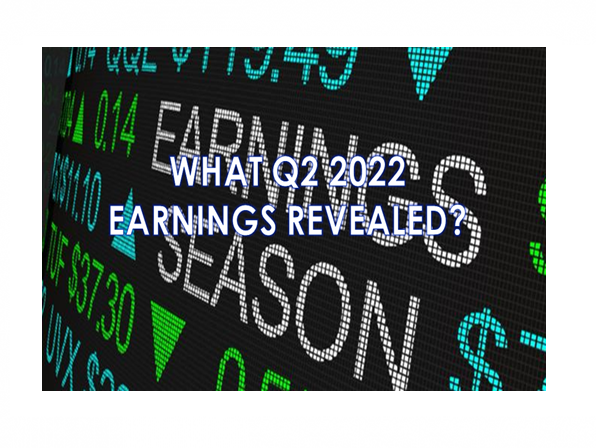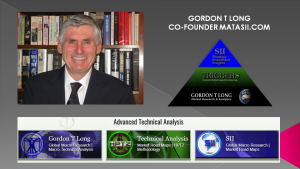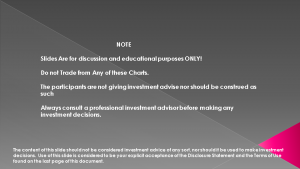IN-DEPTH: TRANSCRIPTION - LONGWave – 08-10-22 - AUGUST – What Q2 Earnings Revealed!
SLIDE DECK
TRANSCRIPTION
SLIDE 2
Thank you for joining me. I'm Gord Long.
A REMINDER BEFORE WE BEGIN: DO NO NOT TRADE FROM ANY OF THESE SLIDES - they are COMMENTARY for educational and discussion purposes ONLY.
Always consult a professional financial advisor before making any investment decisions.
COVER
In last month’s LONGWave entitled “An Earnings Recession” we discussed some of what we would be looking for in the 2022 Q2 earnings. They are now almost complete and we need to draw some conclusions on what they both confirmed and revealed so far!
AGENDA
As such I would like to address the subjects listed here.
- OUR THINKING PRIOR TO THE Q2 EARNINGS,
- WHAT WE WERE LOOKING FOR IN THE EARNINGS AND GUIDANCE CALLS,
- WHAT WE LEARNED & HAD CONFIRMED,
- WHAT WE NOW EXPECT, and
- SOME RELATED CONCLUSIONS.
SLIDE 5
What was central in our thinking prior to the Q2 Earnings Season was:
- Whether we were witnessing a potential consumer led recession and whether it may in fact be a harbinger of a potential secular change in the US consumer.
- Could we be witnessing a secular shift in interest rates (which have been falling for 40 years) be the triggering shift in consumer spending?
- Also, very importantly, what was the significance of the dramatic difference in Top-Down versus Bottom-Up Earnings estimates? Was this a consequence of a new inflationary period we have recently entered into?
SLIDE 6
As long term investors this chart best highlights why we were grappling with these possibilities.
We have long talked about Creditism at MATASII.com and have been ardent followers of those lenders supplying that Credit and where their source of funding originated form. While there are many different kinds of lenders, there are only three Sources of the Funds they lend which can best be categorized as:
- Savings,
- Money Creation or
- Credit Creation.
This approach is particularly useful in demonstrating that the economy is dependent on Credit Creation to fund economic growth, rather than on Savings. This chart illustrates this and why we think it is important.
At the end of last year, Savings had funded only 20% of all US Debt, whereas Credit Creation had financed 53% of all the Debt (with the Fed and Other Countries financing the rest through Money Creation). This is important because the heavy reliance on Credit Creation makes the economy particularly more sensitive to interest rates.
This helps explain why GDP contracted in both the first and the second quarter of this year even though the Fed has only increased the Federal Funds Rate to a range between 2.25% and 2.5% -- so far.
With the Fed intent on continuing to hike interest rates aggressively, it also suggests that the US economy could be in for a much harder landing than most economists are now expecting.
It is astonishing that the Federal Reserve has financed 10% of all the Debt in the US and that ‘Other Countries’ have lent the United States nearly $15 trillion and thereby financing 17% of all the country’s Debt.
How is the US to grow GDP going forward and for corporate earnings to expand if US credit creation continues to deteriorate? How high will interest rates have to rise to attract foreign investment – especially if inflation continues to be a problem?
SLIDE 7
US Equity markets have steadily risen since the 70’s as this chart shows by the rising channel of the S&P 500 from the bottom left to top right. Meanwhile interest rates have mirrored this rise as they fell during most of that period as shown by the gold colored 10Y Treasury note yield line from the top left to bottom right.
Consumers have been able to increase consumption allowing the US Economy to become a 70% consumer economy. This in turn has sustained steady corporate earnings growth. The question is how do rates fall further from the Zero Bound and can the US actually sustain being a 70% consumption economy? Especially when we consider we have a heavily indebted US consumer facing higher rates and most importantly with falling real disposable income in a potential era of continued elevated inflation levels?
SLIDE 8
Stocks are currently priced at historically low trailing earnings yield of 2-3% which means we are currently willing to pay a big price for earnings.
SLIDE 9
You can see here that the S&P 500 Trailing 10Y Annualized Returns are very cyclical, rising and falling over basically 10 year periods. If history is any indication then we are at the cusp of entering another 10Y period of falling stock returns?
SLIDE 10
This is signaled and illustrated here when we look again at the S&P 500 trailing 10Y Earnings yield but compare it to the corresponding 10 Year Forward Earnings. As we saw previously with trailing earnings at 2-3% we should expect forward returns to be historically low.
SLIDE 11
The issue is that in an inflation era of high Inflation we can fully expect PE ratios to be under attack – which they have been since the first of the year. With US CPI at over 9% this historical chart suggests market PE ratios of 10-15% are to be expected versus in the 20’s which we have become quite accustomed to.
SLIDE 12
Stocks are likely to catch down to bond returns, even if bond returns improve with the Fed pivoting from Quantitative Tightening (QT) to the resumption of Quantitative Easing (QE) - which the market is fully expecting to occur later this year or early in 2023.
SLIDE 13
Our view going into Q2 earnings season is that we are on our way to approximately 3270 on the S&P 500 by Q3/Q4 before reversing as the Fed comes off its’ QT policy stance.
SLIDE 14
However, as we stressed in last month’s video we felt a short term counter-rally was to be fully expected even though earnings would be weak with concerning forward guidance.
As we release this video that is exactly what we have experienced by the circled W-X leg of the WXY Elliott wave pattern we have been expecting on the way to 3270.
SLIDE 15
Once the counter rally is complete and we have reached the lower ~3270 pivot area, we expect a strong rally to reach towards prior highs. Again this will be a direct result of the Fed reversing from QT to QE. We expect to see “QE on steroids”, as a serious recession unfolds and the Fed tries to arrest the ensuing damage!
SLIDE 16
Longer Term our view continues to be expectations of falling returns throughout the remaining part of this decade.
SLIDE 17
Market returns will be reflective of falling US Standards of Living as measured by Household Net worth as a Percentage of Disposable Personal Income. It will be a period of heightened Inflation and intractable Stagflation.
SLIDE 18
That was our view going into Q2 Earnings. So what were we looking for in the Q2 results to prove we were right or simply mistaken?
We felt that answer would be about how the markets would handle the earnings in an era of higher inflation. This is something few have seen before and it prompted us to do a lot of examination of similar periods in the 1970’s.
Especially, since we had also observed similar major distortions between Top-Down Pricing and Bottom-Up PE Pricing.
SLIDE 19
The first leg of the downward correction in the equity markets has been the result of a compression in PE ratios down globally in the MSCI World Index by over 28% (as show here) and to below 16 in the S&P 500. This represents what investors are willing to pay for current earnings. The question that needs to be asked is whether an actual drop in corporate earnings is going to be the driver of the next big leg down in the equity markets and specifically in the S&P 500?
SLIDE 20
This chart shows a longer time frame for PE ratios for the S&P500 Large Caps overlaid with recessions. Clearly Recessions drop both PE ratios and earnings. We considered carefully the impact of a potential recession and concluded that PE Ratios are currently still only pricing in a moderate shorter term (12-15 month) US recession. We believe it will be worse than that and more global in scope.
SLIDE 21
| This chart is intended to show how market price draw-downs in PE ratios during eras of high inflation versus low inflation compares to adjustments in corporate earning per share (EPS).
· In times of low inflation (right side of the chart), Market Capitalization (in black) as in the first half of 2022, went down by ~20% due to primarily valuation contraction as: o Inflation rose, o Yield rose and o Yet equity prices rose? · Meanwhile EPS (shown by the red line) has yet to come down. · This is different to what happened during the Dotcom bubble implosion in 2000-2001 and during the GFC in 2007-2008, when earnings went down in-line with falling market capitalization. o Economic Growth in these cases was priced to downside, o There was no valuation contraction before earnings actually started coming down, o Earnings (EPS) shortfalls actually led the equity markets lower. · This was substantially different to what we are seeing currently. · To understand we need to go back to the high inflation episodes that occurred in the 1970 (on the left hand side of the chart): o We see a much more similar dynamic to what we are seeing today. o The 1973 episode, for example, saw prices coming down in anticipation of earnings coming down. o However, when earning (EPS) did finally start to come down the market pricing rebounded having found a bottom! o We see a similar dynamic in 1966 and 1989. o Markets were driven a lot more by inflation than earnings. PE's were pricing in the coming EPS drop. When the drop in EPS came the markets were already pricing in the expected Fed pivot. o Clearly in high inflation episodes the markets begin to price in advance very significantly, because this is a predictable dynamic. o This is due to a lot of tightening delivering an economic slowdown. o Investors are able to price in the slowdown in advance. This is something that can be calculated. |
|
SLIDE 27
So what we should look for is that when average Earnings from a Bottom-Up go negative then the market’s current leg should be expected to reverse.
SLIDE 28
So what happened in Q2? The main highlights are:
KEY METRICS
- Earnings Scorecard: For Q2 2022 (with 87% S&P 500 companies reporting actual results), 75% of S&P 500 companies reported a positive EPS surprise and 70% of S&P 500 companies reported a positive revenue surprise.
- Earnings Growth: For Q2 2022, the blended earnings growth rate for the S&P 500 is 6.7%. If 6.7% is the actual growth rate for the quarter, it will mark the lowest earnings growth rate reported by the index since Q4 2020 (4.0%).
- Earnings Guidance: For Q3 2022, 42 S&P 500 companies issued negative EPS guidance and 30 S&P 500 company issued positive EPS guidance.
- Valuation: The forward 12-month P/E ratio for the S&P 500 is 17.5. This P/E ratio is below the 5-year average (18.6) but above the 10-year average (17.0).
SLIDE 29
The fact that Earnings are still positive is the big tell!
The market overall is not ready to reverse! It is still in an Inflationary Bear Market. Until Energy starts to reverse this will be the case.
What is critical to understand is that doesn’t mean the Bear Market can’t have a counter rally, and as I will show in a moment, that counter rally can be large. However, until the bottom-up earnings go negative the Bear Market can’t be counted on to have reversed!
We are clearly close to a reversal but have more downside to go and our 3270 target is still ahead. Q3 will be important.
SLIDE 30
In addition, the market has not punished S&P 500 companies that have reported negative EPS surprises on average.
Companies that have reported negative earnings surprises for Q2 2022 have seen no price change (0.0%) on average two days before the earnings release through two days after the earnings release. This percentage is well above the five-year average price decrease of 2.4% during this same window for companies reporting negative earnings surprises.
In fact, if this is the final percentage for the quarter, it will mark the first time the index has not seen a negative price reaction on average to negative EPS surprises reported by S&P 500 companies for a quarter since Q1 2009 (+0.3%).
SLIDE 31
So what can we now expect?
Well certainly a short term Bear Market Counter Rally.
However the Bear Market is not over and we should expect:
- A US Consumer Lead Recession to begin to unfold. Maybe it should be better called a “Cost of Living’ Recession,
- The rapidly rising US$ will soon lead to and create a Global Credit Event,
- When the Fed signals a shift to Rate Hikes then the US Dollar will weaken,
- US$ weakening will Improve US Earnings & Exports, which Improves an EPS Reversal.
Yield Curve Inversion Is Currently Signaling:
- Fed Policy Is Wrong
- A Recession is occurring or close at hand.
SLIDE 32
The near term bear market counter rally can be expected to be relatively significant. Bear market rallies get larger as the bear market gets deeper and older (as we show here from 2000-2002).
SLIDE 33
.. or from 2008-2009 as shown here.
SLIDE 34
Both align with our Elliott Wave WXY expectations chart we showed earlier.
SLIDE 35
The rally in everything has 'eased' financial conditions again - almost exactly the same amplitude of easing we have seen 4 other times during this tightening cycle.
We have seen this cyclical shift before with lower highs (tighter peaks to each easing sub-cycle) and lower lows (tighter tights) ... suggesting perhaps The Fed is well aware that tightening aggressively in one big batch will crush the market (and the economy), so perhaps a 'gently does it' approach is more palatable... and judging by the amplitude of this 'easing sub-cycle', we should be facing another tightening leg down...
I belief the current lift shown here will extend further than indicated before heading towards 3270.
SLIDE 36
As Nomura's Charlie McElligott notes:
"The trick here is this next few weeks window, where the resumption of Fed-speak could begin to lean back into the market’s impulse EASING of Financial Conditions Index.
SLIDE 37
The last 4 times the spread between New Orders and Inventories in the ISM Manufacturing Index was this negative, the US was already in a recession.
The 2001, 1990-91, and 1981-82 recessions never had readings this low...
In other word we still have further to go in this Bear Market.
SLIDE 38
Americans' (Adjusted) Misery Index is at its worst level since Jimmy Carter was president.. And if everything was so 'not recession'-like - why would consumer sentiment and presidential approval ratings be at record lows?
SLIDE 39
So what can we conclude overall?
- The Market is front running the Fed Pivot but it is likely too early. I suspect the Fed sees its policy thinking to be an “L”. A further major drop in financial assets then a more protracted period of holding rates higher longer. We will see if they have the fortitude for that when the politicians start screaming.
- A Secular US Consumer Recession is underway or soon will be and I feel should be better described as “A “Cost-of-Living” Recession”.
- The “Great Unrest” we are currently seeing with resignations, labor participation rates, early retirements and the fallout from Covid Employment mandates will bring sustained labor pressures.
- Labor pressures will keep wages elevated which along with Energy and Food inflation will be bad for the market’s overall
SLIDE 40
That is why I see three phases of Inflation going forward. I have been writing about this in my recent newsletters.
We have completed Phase I but still have Phase II and III ahead.
Phase II will be primarily about an energy and extraction process crisis while Phase II will be about an unprecedented global food shortage. I refer you to your MATASII newsletters for more detail.
SLIDE 41
These are all part of the unfolding Commodity Super-Cycle which will go through the stages shown on the right.
SLIDE 42
Again, as we outlined in our newsletters we saw this inflation pattern twice before. Both episodes were when inflation was sustained at over 5-6%. Most recently in the 70’s as shown on the left with where we are in Phase I on the right in comparison.
SLIDE 43
… and prior to that in the 1930’s into WWII.
SLIDE 44
Currently the Federal Reserve isn’t even in the ball park of fighting inflation ever mind the issues associated with the drivers behind the Commodity Super-Cycle. The problems are only beginning – not behind us as inflation we suspect in the near term begins to cyclically appear to be weakening.
SLIDE 45
The last observation I leave you with is that you need to understand that the three phases of the Commodity Super-Cycle and Inflation is a schematic.
In actuality the final market action ahead will appear as a “M” top.
SLIDE 46
Then we start a more protected downward reduction in returns over the remaining part of this decade.
SLIDE 47
As I always remind you in these videos, remember politicians and Central Banks will print the money to solve any and all problems, until such time as no one will take the money or it is of no value.
That day is still in the future so take advantage of the opportunities as they currently exist.
Investing is always easier when you know with relative certainty how the powers to be will react. Your chances of success go up dramatically.
The powers to be are now effectively trapped by policies of fiat currencies, unsound money, political polarization and global policy paralysis.
SLIDE 48
I would like take a moment as a reminder:
DO NO NOT TRADE FROM ANY OF THESE SLIDES - they are for educational and discussion purposes ONLY.
As negative as these comments often are, there has seldom been a better time for investing. However, it requires careful analysis and not following what have traditionally been the true and tried approaches.
Do your reading and make sure you have a knowledgeable and well informed financial advisor.
So until we talk again, may 2022 turn out to be an outstanding investment year for you and your family.
Thank you for listening.





